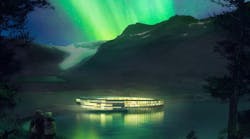In 2021, international architecture and design firm Snøhetta will debut a futuristic building concept in the Arctic Circle: Svart - the world’s first energy positive hotel.
Renowned hoteliers, Adrian Zecha and Jonathan Breene, will be the managing operators of the facility once it opens. Zecha said the location, integrity of design honoring the site and the use of traditional building characteristics are what caught their attention when considering the position.
Resting at the base of the Svartisen glacier in Norway, circular-shaped Svart will feature breathtaking views of the Northern lights and the clear waters of the Arctic fjord. A collaboration between MIRIS, Snøhetta and Powerhouse, Svart will be the world’s first hotel designed after the energy-positive Powerhouse standard.
What Is the Powerhouse Standard?
Founded in 2011, Powerhouse represents a collaboration in the development of energy-positive buildings, and consists of property company Entra, entrepreneur Skanska, environmental organization Zero, Snøhetta architects and consulting company Asplan Viak.
The original idea behind the alliance was that it takes more than one team to build a positive-energy building, according to Rune Stene, Powerhouse’s managing director.
[Check out: Leaning Tower of... San Francisco?]
To reach the rigorous Powerhouse standard, a building must be an energy-positive facility that, in the course of a 60-year period, generates more renewable energy than the total amount of energy that would be required to sustain daily operations, and to build the building, produce materials for it and demolish it.
(Photo Credit: Snøhetta Plompmozes)
Below are examples of characteristics typically found within a Powerhouse building:
-
Material choice is based on energy used for extraction of raw materials, product and transport
- Solar energy is captured through photovoltaic panels on the roof and facade
- Surplus energy is made available for infrastructure in the vicinity of the building
- Sea water and heat pumps are used for cooling and heating
- Uses power in winter and delivers power in summer
- Open floor plans allow for energy-efficient air distribution
- LED lighting regulated by sensors adjusted for the level of daylight and human presence
- Bright colors for walls and ceilings to brighten the space
- Rooms in the core of the building have glass panels and doors in the walls facing areas with low noise requirements to maximize natural light without increasing embodied energy
To reach the rigorous Powerhouse standard, a building must be an energy-positive facility that, in the course of a 60-year period, generates more renewable energy than the total amount of energy that would be required to sustain daily operations, and to build the building, produce materials for it and demolish it.
In Svart’s case, this means that by around 2080, the hotel will have produced more energy than it cost to create and operate. It will likely meet its goal considering the building is proposed to reduce its yearly energy consumption by 85 percent compared to other modern hotels. Svart will also harvest enough solar energy to cover both its operations and the energy needed to construct it.
World's Largest Underwater Restaurant
Why eat somewhere that has a view of the ocean when you can now eat IN the ocean?
Appropriately named Under, this latest dining experience submerges guests 18 feet below the icy waters of the North Atlantic and invites them to take in a dramatic backdrop of marine life on the ocean floor.
While other certifications like LEED, WELL and BREEAM consider environmental or social factors, the Powerhouse standard focuses solely on plus-energy facilities.
“There is no other concept as challenging as Powerhouse that we know about, when it comes to energy,” says Stene. “There are several plus-energy buildings around, but they typically only account for the operational energy, not the entire lifecycle. The material embodied energy is a substantial part of the building.”
(Photo Credit: Snøhetta Plompmozes)
How to Become Powerhouse Certified
Stene states that there isn’t necessarily a certification process. Rather, a report must be gathered that details exactly how the energy budget comes together to create a surplus.
[Related: 10 Tips for Green Building Certification]
When construction on a proposed Powerhouse building such as Svart is complete, the Powerhouse alliance checks the numbers (which are open to public record) to ensure that the facility is up to its standards. Stene says that, so far, Powerhouse has completed two projects, two are currently in construction and three are in design (including Svart).
“Powerhouse can be built all over the world,” he adds. “We have trademarked the logo and concept in the European Union, the U.S. and Norway.”
Plus-Energy Powerhouse Projects
The two completed projects include Kjørbo in Sandvika, Norway, a rehabilitated office building, and Drøbak Montessori school, the most environmentally-friendly school in Norway. Stene notes that the cost to become a Powerhouse building largely depends on whether the building will be newly constructed or refurbished.
“In Norway, energy-ambitious projects can get financial support from a public program, which means total cost is not far from ordinary buildings,” Stene says. “On the other hand, these buildings have an [estimated lifespan till around] 2035-2040, which means they are what we call ‘future proof.’ For the client, the attraction of tenants is important. The Powerhouse is a concept that appeals to many tenants that want to brand themselves as ‘climate friendly/ sustainable.’”
Help BUILDINGS Shape 2019!
What BUILDINGS resources are most valuable to you? What would you like to see us provide?
Please take our short (under 2 minutes) survey - just 5 short questions.
Thank you!
Powerhouse standards for projects like Svart may be demanding, but this energy-positive certification may just be gaining notice at the right time. Green building is exploring new directions like health and wellness and, considering that buildings account for 40 percent of global energy consumption today, we can all benefit from transforming them from energy consumers to energy producers.
Two handpicked articles to read next:




